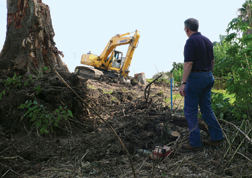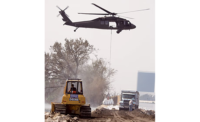By the end of July, a contractor for the New Orleans District of the U.S. Army Corps of Engineers should finish a much-contested tree-and-fence removal project on a two-mile stretch of levee lining the city’s 17th Street outfall canal. The project is part of a new nationwide push by the Corps to ensure inspection and maintenance access to levees and flood-protection structures, says the Corps.
 Angelle Bergeron / ENR Corps is clearing levees as part of a nationwide program to ensure access.
|
Three Fold Consultants LLC, New Orleans, has a $784,000 contract to remove fences, trees and stumps and backfill and compact resulting cavities within six feet of the levee toe on the east side of the canal. A breach there during Hurricane Katrina caused disastrous flooding.
Steve Finnegan, a project manager for the Corps, says tree roots in levees can provide channels for seepage. “Additionally, roots ripped out during a tropical storm would worsen the seepage and reduce the stability of the levee, potentially resulting in failure,” he explains.
The contractor expects to remove 313 trees, 39 stumps and 4,410 ft of fence, says Michael Stout, project manager with MWH Americas Inc., which is providing program management to the district for its levee-clearing work.
Similar work is going on nationwide, including more than 900 miles of Mississippi River levees and levees in the Atchafalaya Basin, but “this has certainly been the most difficult stretch in terms of working through the various issues,” Stout says. In other parts of the country, local sponsors are paying for tree removal. Municipalities are levying taxes and selling bonds to ensure levees are in compliance with the Corps’ standards. But Stout says the Lake Pontchartrain East Bank protection project in New Orleans is unique, in that the Corps is paying 100% of the tree-removal cost “because of the damage of [Hurricane] Katrina, the level of damage and the limited resources of local sponsors.”
As a safety measure, the Corps also will install temporary chain-link fences around backyards of 23 properties with swimming pools. “We thought it would make sense to put up permanent replacement fences, but we aren’t able to find authority for that,” Stout says. The portion of Three Fold Consultants’ contract dedicated to temporary fence installation is $58,000, Stout says.
The Corps has “bent over backwards” to accommodate residents, says Stevan Spencer, executive director of the Orleans Levee District (OLD). He says the district’s lawyers feel there is no legal requirement for either property owners or the levee district to fence backyards off from the levee. “If we were [clearing the levees], we wouldn’t be obligated to replace the fences,” Spencer says.
The Corps wanted to have the work finished by mid-July, the start of peak hurricane season. But some residents along the canal contested the legality and need for it for more than a year, until the Southeast Louisiana Flood Protection Authority-East voted over their objections to let the Corps proceed on May 15.
Then a June 30 start date slipped to July 5 after the residents said they had not receive timely notice, allowing them two weeks to do their own removals from the “clear zone,” says Spencer. Although state law only requires a five-day notice and the residents knew it was coming on May 15, OLD pushed the start date back to give them more time, Spencer says.
As soon as the work is finished on the east side of the canal, the Corps will move on with similar work on the west side. “That area is pretty much the same length, but the majority of it is commercial property, apartment complexes or condos,” Stout says. “It won’t be so much going in people’s backyards, except maybe 15 or 20 properties.”
Three Fold Consultants met with residents before the project to hear their concerns, says Bassam Mekari, owner. “Some of them have asked us to move smaller trees and shrubs to within the new line, and we are going to do the extra work to please them,” he says.


Post a comment to this article
Report Abusive Comment